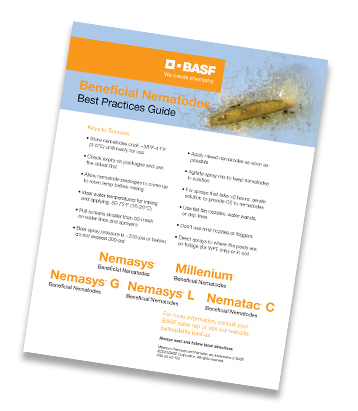Shore flies are controlled using Steinernema carpocapsae nematodes, such as the Millenium Beneficial Nematode product from BASF. These nematodes infect and kill shore fly larvae in the media. Regular nematode drenches are an important component of controlling this pest. A drench at seeding is recommended for plants grown in hydroponic environments or container production. Follow up drenches can be performed every two to three weeks. Nematode drenches can also be applied to under bench areas, crevices, and drains. Closely following several nematode best practices can ensure growers get the most out of their nematode products and applications.
Check nematode viability. Visually identifying living nematodes is simple with appropriate magnification tools. Living nematodes retain a curly shape, resembling curly noodles or curvy letters like C’s, S’s, and J’s. Dead nematodes quickly take on a toothpick-straight appearance. Nematodes cannot be seen with the naked eye, but can be visualized under 20x or greater magnification. Powerful hand lenses or light microscopes may be used to observe nematode samples. Once mixed in solution, inspect a sample under magnification.
Make sure you receive and store nematode products properly. Nematodes should be stored at 35-41°F in unopened containers in a refrigerator, away from contact with side walls. When properly stored, nematodes can remain healthy and viable in this environment for up to 5 weeks.
Do not mix nematodes with oxidizers or sanitizers. Nematodes are delicate creatures and can be immediately impacted by contact with sanitizers or oxidizers. Do not mix nematodes in stock tanks with these types of products and avoid drenching these types of products immediately after nematode applications.
Make sure nematode solutions remain agitated and aerated. Nematodes are living creatures and can quickly drown when oxygen depletes from their solutions. They are also heavy and will settle to the bottom of containers in a relatively short amount of time, leading to potentially uneven applications. To avoid either of these situations, utilize an aeration manifold with a bubbler, a specialized aeration bucket like those provided by Dramm, or agitation pumps and mixers to keep solutions aerated and evenly mixed. Also, remember to remove mesh screens of 50-mesh or smaller from your equipment prior to application.
Apply under lower light conditions and avoid extended UV exposure. Though nematodes should never be frozen and should be allowed to come to room temperature prior to application, no active heating or sunlight exposure is required or necessary. In fact, beneficial nematodes are damaged by UV light from natural or artificial sources. Best practices call for application under low light conditions.
Griffin’s GGSPro team can help you in determining appropriate use rates for your specific crop size and growing style. If you struggle with shore fly control, reach out to your Griffin sales rep today!
Make sure you receive and store nematode products properly. Nematodes should be stored at 35-41°F in unopened containers in a refrigerator, away from contact with side walls. When properly stored, nematodes can remain healthy and viable in this environment for up to 5 weeks.
Do not mix nematodes with oxidizers or sanitizers. Nematodes are delicate creatures and can be immediately impacted by contact with sanitizers or oxidizers. Do not mix nematodes in stock tanks with these types of products and avoid drenching these types of products immediately after nematode applications.
Make sure nematode solutions remain agitated and aerated. Nematodes are living creatures and can quickly drown when oxygen depletes from their solutions. They are also heavy and will settle to the bottom of containers in a relatively short amount of time, leading to potentially uneven applications. To avoid either of these situations, utilize an aeration manifold with a bubbler, a specialized aeration bucket like those provided by Dramm, or agitation pumps and mixers to keep solutions aerated and evenly mixed. Also, remember to remove mesh screens of 50-mesh or smaller from your equipment prior to application.
Apply under lower light conditions and avoid extended UV exposure. Though nematodes should never be frozen and should be allowed to come to room temperature prior to application, no active heating or sunlight exposure is required or necessary. In fact, beneficial nematodes are damaged by UV light from natural or artificial sources. Best practices call for application under low light conditions.
Griffin’s GGSPro team can help you in determining appropriate use rates for your specific crop size and growing style. If you struggle with shore fly control, reach out to your Griffin sales rep today!
| Item # | Description | Supplier |
|---|---|---|
| 70-2455 | Millenium, fve gel trays, 250 mil/tray | BASF |
| 70-2457 | Millenium, six gel trays, 1.5 bil/tray (9 bil total) | BASF |
| 30C125B | NEMAForce SC, single gel tray, 1.5 bil/tray | Beneficial Insectary |
| 30C250 | NEMAForce SC, single gel tray, 250 mil/tray | Beneficial Insectary |
| 30C250M | NEMAForce SC, ten gel trays, 250 mil/tray (2.5 bil total) | Beneficial Insectary |
| 30C50 | NEMAforce SC, single gel tray, 50 mil/tray | Beneficial Insectary |
| SB1012-01 | Exhibitline SC, single gel tray, 250 mil | Bioline AgroSciences |
| SB1012-02 | Exhibitline SC, single gel tray, 50 mil | Bioline AgroSciences |
| 74-2686 | Agitation/Aeration Bucket, 100-120V AC, #AAB120V | Dramm Corporation |
| 74-2687 | Agitation/Aeration Bucket, 12V/DC, #AAB12V | Dramm Coporation |
